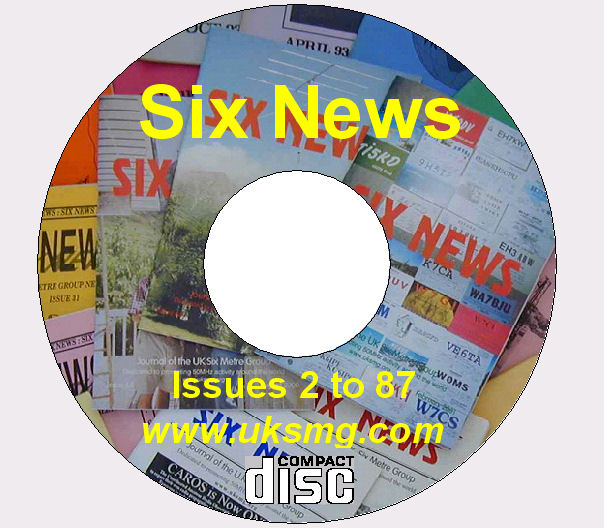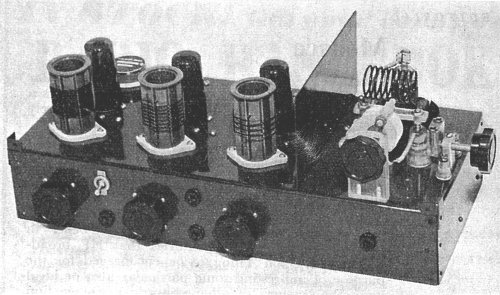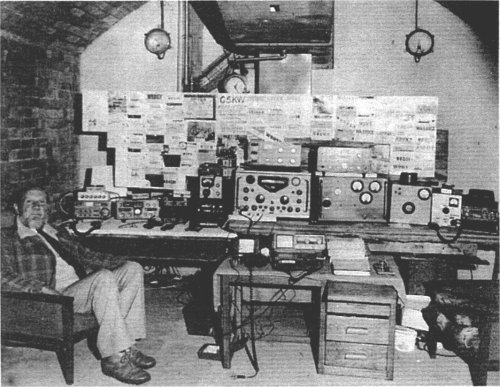

home > archive > the history of 6m > 50 years of 50 MHz part 2

Thanks to all of our authors since 1982!
50 Years of 50 MHz Part 2 - Ken Willis, G8VR |
|
|
It is true that prior to this several British amateurs had been experimenting in this part of the spectrum, but equipment in those days was, by present standards, extremely primitive. The day of the transistor and solid-state technology had not yet dawned. Transmitters and receivers used valves, components were large, and rigs were mostly home-constructed. Remember too, that with the components and technology of the era, 50 MHz was considered to be a very high frequency for which variable frequency oscillators of sufficient stability were difficult to construct. We used crystal-controlled transmitters - not for us the luxury of single sideband and listening on one's own frequency for a reply. After a CQ call the whole band had to be searched for a reply; conversely on responding to a CQ one just prayed that you would be the first station heard when the caller tuned the band. Incredible though it may seem today, UK amateurs at the time were not permitted to call `CQ'. To comply with the Government's insistence that under the terms of our licences we were simply experimenters, not communicators setting up in competition with official telegraph agencies, I had to call "Test, Test de G8VR", using either CW or telephony, a pretence that every transmission was a scientific experiment! The contact between G6DH and W1HDQ, both dedicated 28/50 MHz operators, showed that carefully designed equipment and careful monitoring could bring results. This led to a great surge in interest in "Six" with several stations now devoting their time to building receivers and aerials for the band. At this time, once the special short-term licence issued to G6DH had expired, no British amateur held a licence permitting transmission 50 MHz band so contacts with overseas six-metre stations could only be achieved by cross-band operation, with UK amateurs transmitting on 28 MHz. Much envied, and alone in this wilderness, was Harry Wilson EI2W, who was the only station in northern Europe to hold a 50 MHz transmitting licence. UK amateurs had 58 MHz (five-metre) facilities and several built transmitters that would cover both 58 MHz and 50 MHz. Figure 2 shows a typical 50/58/28 MHz AM transmitter using plug-in coils on a standard 19-inch chassis of the era, the crystal being visible at the rear on the left.
As the next solar maximum approached in 1956-57, many British stations were now equipped to make cross-band contacts with 50 MHz stations. EI2W was having a ball, envied by all in his ability to work two-way on Six. With, by now, a large UK contingent of 50 MHz operators there was no dearth of stations to work Stateside, while several Canadian and South African stations were also regularly on the band. Al Slater G3FXB, a legendary contest operator, had by now turned his attention to the band and could be heard working W stations one after another from his QTH in Horsham, Sussex. By the next solar peak, 1967/68, things had changed. Sideband and compact transceivers had replaced AM, so no longer was it necessary to dig out a signal on a crowded band from a mass of heterodyne whistles produced by adjacent carriers. Better still, spot-frequency working with a modern transceiver did away with the tiresome need to tune the whole band after calling CQ - which incidentally was now permitted, through a change in licence conditions. In this cycle, however, Old Sol decided to take a rest and six-metre propagation proved to be something of a disappointment for the large number of operators who had waited so long and were equipped to listen on the band. During the quiet years that followed from 1970, six-metre activity in the UK was at a relatively low level, but in 1978 the ever-watchful Ed Tilton, W1HDQ, was heard the ZB2BL beacon. This evidence that things might be heating up resulted in plans for a series of transatlantic 50/28 cross-band tests starting in early 1979. Fortunately the tests coincided with favourable conditions, and in the first transatlantic opening since 1958, Brian Bower G3COJ, was first on the scene when on February 10th he contacted WB2RLK/VE1. G3FXB was soon back in action and made several transatlantic contacts on the same day and during the following weeks. Everyone started to have fun with cross-band contacts and EI2W started up again in earnest. Within a year he had brought his total of US states worked two-way on Six to forty, comprising 300-plus stations worked in all USA call-areas. So far in this story I have not mentioned any participation by Ken Ellis G5KW, who sadly became a silent key recently. He was never far away from the action. In 1979 Ken was living in a Kent village adjacent to mine, in a good location high up on the Weald and capable of providing good two-metre and 70 cms DX via tropo. But Ken's band was six metres. Although equipped with good antennas and a sensitive receiver, he was frustrated to hear other stations to his west and southwest in cross-band QSO with W and VE stations that were completely inaudible at his QTH. In particular he noted that Al Slater, his nearest 50 MHz station - located in Horsham some 50 or so miles to the west - was working USA stations one after another on 50 MHz, none of the DX being audible in Kent. There was only one solution. If the DX would not come to him he must go to the DX, but how to do it when his home was in Kent? He drove up to my house one Sunday evening in a disreputable-looking vehicle that he described as `a retired ambulance'. He had bought and converted it into a combined shack and living quarters. It was loaded down with a 230-volt AC generator, a 12-volt generator and a pair of very heavy-duty 12-volt batteries. But these were minor loads compared with the sundry items of hardware lashed to the roof. First was the two-section 40-ft tower, then a five-element yagi and a trap dipole for ten metres. For 50 MHz a massive Cushcraft six-element yagi on a 34-ft boom, specially air-freighted from the USA, overhang both ends of the vehicle. Inside were "other small beams for comparison purposes". Inside, a KW2000B HF transceiver with associated KW1000 linear were fixed to a bench, while for Six there was an ICOM 551 and a Yaesu 620B. Ken briefly outlined his plans, which were to take this caravanserai to the Channel Islands, where, he concluded, he would be nicely situated to catch the transatlantic DX on six metres. I wished him luck as he drove off emitting smoke, while my incredulous neighbours watched from behind lace curtains. Ken set off in October 1979, but unfortunately he had not done all of his homework. On arrival at the ferry he learned that caravans were not permitted on the Channel Islands. Plan B. He decided that the Scillies would be near enough. At Land's End, officialdom raised doubts whether he would be allowed to land at St. Mary's. He was permitted on to the ferry only on condition that he would return on the same ferry if refused permission to go ashore. All turned out well and he was given permission to operate from the Garrison Fort, on high ground towards the south-western tip of the island. This was to be the first of three trips to the Scillies where he stayed for months at a time, bracketing the DX season between October and January, though records show that he did go home for Christmas in 1981! My picture (figure 3) shows how the G5KW set-up expanded beyond the initial caravan installation into a well-equipped barn, access to which he had been given through friends he made locally. He monitored 50 MHz continuously from daybreak until dark. The decision to go to the southwest was justified from the outset, since almost daily contacts with VE1AVX became the norm. Ken's propagation studies and conclusions have been fully documented elsewhere and would take much space to reproduce. Highlights were a cross-band with VK6OX on 27th October 1980, following Gordon Pheasant, G4BPY and Brian Bower, G3COJ. These were the only three VK contacts with VK on the 50 MHz band until 1990, by which time it was possible for two-way QSOs to be made.
For me, the achievement which gives an indication of the long hours Ken spent listening to white noise issuing from his speaker is the fact that he had cross-band contacts with all 48 mainland states of the USA from the Scillies. The last ferry before Christmas 1981 left on December 16th. He planned to operate until 14th, but still needed Utah. Most of the afternoon on that last day he called CQ Utah, for some reason listening for replies only on six metres rather than the cross-band calling channel of 28885 MHz. Meanwhile several American stations were calling desperately to tell him that W5VLJ/7 was trying to raise him on Six from Utah. In the nick of time the contact was completed. . Next time you fancy going out for a spot of portable operating make sure you don't forget the kitchen stove.
UKSMG Six News issue 71, November 2001 |
the early history of 6m
six in fifty-seven
down memory lane
6m history
historical 6m
rigs
6m history by G6DH
50yrs of 50megs
pt1
50yrs of 50megs pt3
50yrs of 50megs pt4


